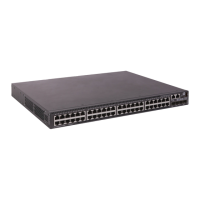95
FIPS compliance
The device supports the FIPS mode that complies with NIST FIPS 140-2 requirements. Support for features,
commands, and parameters might differ in FIPS mode and non-FIPS mode. For more information about
FIPS mode, see Security Configuration Guide.
Enabling configuration encryption
Configuration encryption enables the device to encrypt a startup configuration file automatically when it
saves the running configuration. All HP devices running Comware V7 software use the same private key
or public key to encrypt configuration files. Only HP devices running Comware V7 software can decrypt
the encrypted configuration files.
To enable configuration encryption:
Ste
Command
Remarks
1. Enter system view.
system-view N/A
2. Enable configuration
encryption.
configuration encrypt { private-key |
public-key }
By default, configuration
encryption is disabled.
Configuration is saved
unencrypted.
Saving the running configuration
When saving the running configuration to a configuration file, you can specify the file as the next-startup
configuration file.
If you are specifying the file as the next-startup configuration file, use one of the following methods for
saving the configuration:
• Fast mode—Use the save command without the safely keyword. In this mode, the device directly
overwrites the target next-startup configuration file. If a reboot or power failure occurs during this
process, the next-startup configuration file is lost. You must specify a new startup configuration file
after the device reboots (see "Specifying a next-startup configuration file")
.
• Safe mode—Use the save command with the safely keyword. Safe mode is slower than fast mode,
but more secure. In safe mode, the system saves configuration in a temporary file and starts
overwriting the target next-startup configuration file after the save operation is complete. If a reboot
or power failure occurs during the save operation, the next-startup configuration file is still retained.
Use the safe mode if the power source is not reliable or you are remotely configuring the device.
To save the running configuration, use either of the following command in any view:
Task Command Remarks
Save the running configuration to
a configuration file without
specifying the file as a
next-startup configuration file.
save file-url [ all | slot
slot-number ]
N/A

